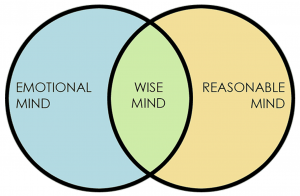Intro
Self-Injury Awareness Day (SIAD) is a globally recognised event aimed at challenging and combating the stigma associated with self-harm. Taking place on 1st March every year, this day allows people to open up and seek available support for a topic people often find difficult to talk about.
At InsideOut we offer one to one sessions and worksheets from Dialectical Behaviour Therapy [1] . DBT is a type of treatment that teaches you how to regulate your emotions [2] and respond to your distress through psychological skills training. Research shows that it is especially effective in people struggling with self-harm and other self-destructive, unhealthy habits or behaviours.[3]
How Do DBT Skills Prevent Self-Harm?
Though DBT can seem complicated at first glance, the training is essentially composed of four modules: mindfulness, distress tolerance, emotion regulation, and interpersonal effectiveness.
Together, these skills teach you how to recognise these emotions, regulate their intensity, and respond to them without the use of unhealthy coping mechanisms.
Mindfulness – How It Can Reduce Or Prevent Self-Harm
Mindfulness is the intentional act of living with awareness in the present moment. It is about acceptance of the present and of all the thoughts, feelings, behaviours, and impulses that that present contains without judgement or rejection.
The main goals of mindfulness are to help you to reduce suffering, experience reality as an active participant, and empower you to feel more in control of your mind and conscious actions.
While mindfulness can be practised anytime and anywhere, core mindfulness in DBT emphasises the practice of three core mindfulness skills: wise mind, “what” skills, and “how” skills.[4]
The ‘Wise Mind’ and States of Mind Skill
According to DBT theory, there are three states of mind that a person can be in at any given time: reasonable mind, emotional mind, and wise mind.
The reasonable mind is cool, rational, and task-focused, and excludes personal values and feelings. The emotional mind is governed by moods, emotions, and urges, and excludes facts and logic. The wise mind is the compromising middle path between the two, acknowledging both reason and emotion, and is considered the ideal state of mind.[5]
‘What’ Skills
The “what” skills in DBT are taught through three active processes: observe, describe, and participate. The goal of these skills is to help you achieve greater awareness of your internal state.
To observe, simply notice and recognise thoughts, feelings, sensations, what you see, what you hear, etc. Pay attention, but do not push anything away or hold onto anything.
To describe, put words and labels on your observations, focusing on the “who,” “what,” “when,” and “where.” Aim for factual accuracy and avoid interpretation. Thoughts and feelings are just thoughts and feelings — not reality.
Finally, to participate, become present in the moment without self-consciousness. Throw yourself into the moment, into your current activity, remain spontaneous and flexible, and act from your wise mind.[6]
‘How’ Skills
The “how” skills in DBT are: nonjudgmentally, one-mindfully, and effectively.
Nonjudgmentally means to see and accept without evaluating as good or bad. Acknowledge differences and the consequences of certain behaviours or events, but not the differences and consequences themselves.
One-mindfully means to practice focus and attention by doing one thing at a time and letting go of distractions to bring yourself back to the present moment.
Effectively means acting from our goals instead of from our judgments. It requires acting in a way that is appropriate for the reality of a given situation instead of one we wish we were in.
The objective of mindfulness in DBT is to develop enough awareness in order to act according to goals and values, free from the controlling forces of both disconnected logic and overwhelming emotion. These are the times when self-harm urges and intrusive thoughts are most likely to occur.

InsideOut and DBT
At InsideOut we have a large pool of therapists ready to support you. If you would like to speak to one of them about DBT treatment, or for any additional help please book a 1-2-1 session via the InsideOut app (if you already have access to this), or get in touch with the team with any questions: [email protected]
By: Dr Becky Lunson Southall – Chief Therapist at InsideOut
References
- Arnold, T., “Core Mindfulness: Dialectical Behaviour Therapy (DBT).” Goodtherapy.org, January 23, 2008.
- Linehan, M., “Mindfulness Handouts: Handouts for Goals and Definitions.” DBT Skills Training Handouts and Worksheets, Second Edition, 2015.
- https://www.healthyplace.com/abuse/self-injury/what-is-self-injury-self-harm-self-mutilation
- https://www.healthyplace.com/blogs/borderline/2016/05/coping-skills-for-borderlines-experiencing-extreme-emotions
- https://www.healthyplace.com/blogs/speakingoutaboutselfinjury/2014/10/insecurity-can-lead-self-harmers-down-unsafe-roads
- https://www.therapistaid.com/search?query=wise+mind






